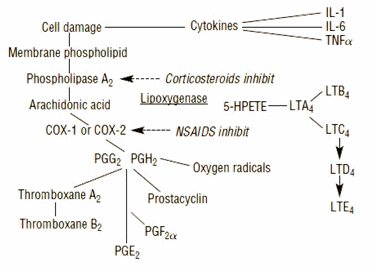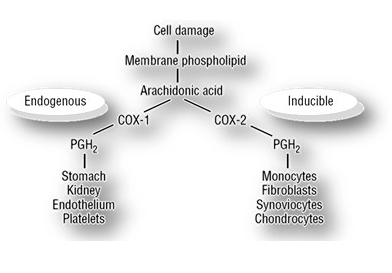



A Guide To NSAIDS
Non-steroidal anti-inflammatory drugs (NSAIDs) are, as a group, the most frequently consumed drugs worldwide. Dr Puneet Agrawal and Dr Amitraj Gupta from Montajat Veterinary Pharmaceuticals Ltd looks at how they work and different brands available.Mode of action:
NSAIDs derive much of their anti-inflammatory properties from their capacity to inhibit the synthesis of prostaglandins (Figure 1). Prostaglandins have important roles in normal physiology that might best be described as protective in nature. Prostaglandins are released in response to injury and have the capacity to provoke vasodilatation, erythema, and hyperalgesia.
Prostaglandin formation is mediated by either one of two isoforms of cyclooxygenase. These are known as cyclooxygenase-1 (COX-1) and cyclooxygenase-2 (COX-2). Cyclooxygenase-1 (COX-1) mediates the formation of constitutive prostaglandins produced by many tissues, including gastrointestinal cells, platelets, endothelial cells and renal cells. Prostaglandins generated from COX-1 are constantly present and impart a variety of normal physiologic effects. These include protection of gastrointestinal mucosa, hemostasis and the kidney when subjected to hypotensive insults. Cyclooxygense-2 (COX-2) catalyses the formation of inducible prostaglandins, which are needed only intermittently (Figure 2).


Kinetics of NSAIDs
Absorption
The NSAIDs share similar absorption properties as all NSAIDs are highly lipophilic substances. Absorption occurs throughout the gastrointestinal tract, but particularly in the stomach of monogastric animals, the pH is normally more acidic than plasma pH. An acidic environment promotes the absorption of NSAIDs which, as weak acids, are less ionized in gastric juice and therefore absorbed by the mechanism of ionic or diffusion trapping. Most NSAIDs are given as oral tablets or capsules; others are given by injection to avoid gastric irritation.
Distribution
The most significant aspect of NSAIDs distribution is plasma-protein binding which is high (>95 per cent) for most NSAIDs, although salicylate is an exception, with binding of ~50 per cent. The major plasma protein component is albumin. The high degree of protein binding limits renal excretion of most NSAIDs. High plasma-protein binding may also limit the distribution of NSAIDs from plasma to body fluids and tissues. However, this does not necessarily limit and may even enhance therapeutic efficacy in acute inflammation because protein leaks from the vascular comparent into inflamed tissues and because drug concentrations in inflammatory exudates commonly exceed those in plasma. Protein binding does limit penetration into fluids such as milk. Flunixin and phenylbutazone have concentrations in milk that are ~1 per cent of the plasma levels, corresponding approximately to the nonbound plasma concentration.
Metabolism
Knowledge of the mechanism of action of NSAIDs, as competitive inhibitors for arachidonic acid binding to COX, provides a good tool to predict whether NSAID metabolites are active or not. Generally, phase-I metabolism of NSAIDs produces more polar products. These polar metabolites are not efficient COX inhibitors because they lack the lipophilic properties to compete with arachidonic acid and prevent its binding to COX. Accordingly, it is easy to conclude that most of the NSAIDs are metabolized into inactive products, which is the case in reality.
Excretion
NSAIDs are mostly excreted as phase-II glucouronides and in a few cases as sulfate conjugates. In addition, small percentages of NSAIDs are excreted unchanged in urine. If the drug is excreted unchanged, its rate of excretion is expected to increase if the drug is coadministered with agents that render the urine pH alkaline such as the antacids aluminum hydroxide and milk of magnesia.
Adverse reactions to NSAIDs
There is a huge spectrum of reactions to NSAIDs, ranging from clinically common gastrointestinal problems to rare ones such as aseptic meningitis. Some of the more common adverse reactions to NSAIDs are described as follows:
| System affected | Adverse reactions |
|---|---|
| Gastrointestinal | Gastroesophageal reflex Erosions Peptic ulcers Gastrointestinal hemorrhage Small and large bowel ulceration |
| Hematopoietic | Impaired blood clotting Impaired platelet activity Blood dyscrasias Bone marrow dyscrasias |
| Renal | Renal tubular nephritis Renal papillary necrosis Acute renal failure |
| Others | Hepatotoxicity Aseptic meningitis Diarrhea CNS depression |
Currently available NSAIDs are indicated for the treatment of mild to moderately severe, acute and chronic pain, inflammation and pyrexia. Non-steroidal anti-inflammatory drugs differ widely in potency and therapeutic efficacy. Differences in efficacy can be explained by varying degrees of COX and cytokine inhibition, non-COX mechanisms, differing analgesia versus anti-inflammatory effects, and wide individual variation in response, within and between species.
A large number of non-steroidal anti-inflammatory drugs, of different chemical groups are available for veterinary use. For the Livestock sector Montajat Pharmaceuticals is providing safe and cost effective NSAIDs for the better management of diseases to ensure optimal production. Some of the known brands are discussed below.
1. Flunixin Meglumine (FLUNIFLAM)
Flunixin meglumine is a non-steroidal anti-inflammatory drug (NSAID) and cyclooxygenase inhibitor. It is a potent analgesic, antipyretic and anti-inflammatory. NSAIDs work by inhibiting the body's production of prostaglandins and other chemicals that stimulate the body's inflammatory response. Some of these actions may be dose-dependent. NSAIDs are quickly absorbed into the blood stream; pain relief and fever reduction usually starts within one to two hours.
FLUNIFLAM is available as five per cent injection and it is indicated for use in horses to alleviate pain and inflammation associated with musculoskeletal disorders, and to alleviate the visceral pain associated with colic.
FLUNIFLAM is indicated for use in cattle to control pyrexia associated with bovine respiratory disease and endotoxemia, and to control inflammation in endotoxemia.
Cattle: 2.2 mg/kg body weight (2 ml/45 kg bw), IV route, once daily for 5 days
Withdrawal time:Meat: 5 days
Milk: 1 day
2. Ketoprofen (KETAFLAM)
Ketoprofen is a propionic acid non-steroidal anti-inflammatory drug (NSAID) with analgesic, antipyretic and anti-inflammatory effects. It acts by inhibiting the body's production of prostaglandin. It is a nonselective inhibitor of COX-1 and COX-2.
KETAFLAM is available as 10 per cent injection and it is used for treatment of pyrexia in dogs and cats. In horses, it is used for musculoskeletal inflammation and pain, abdominal pain and other inflammatory conditions. In cattle, it is used for fever, pain and inflammation, particularly during mastitis due to no withdrawal time.
Cattle, Buffaloes, Camel, Sheep and Goats: 3 mg/kg body weight (1 ml/33 kg bw), IM, IV or SC route, once daily for 3 to 5 days
Withdrawal time:
Meat: 4 days (IM route); 1 day (IV route)
Milk: Nil
3. Tolfenamic acid (TOLFENAC)
It is a non- steroidal anti-inflammatory agent (NSAID), which belongs to the fenamate group. It is a potent inhibitor of cyclooxygenase enzyme, thus inhibiting the synthesis of important inflammatory mediators such as thromboxane (Tx) B2 and prostaglandin (PG) E2. It acts not only by inhibiting prostaglandin synthesis, but it also has a direct antagonistic action on its receptors. The anti-inflammatory activity of Tolfenamic acid was evaluated in various animal models of inflammation.
TOLFENAC is available as four per cent injection and is used for reducing pain, inflammation and pyrexia due to infectious diseases, trauma, surgery and colic.
By IM route- 1 ml per 20 kg bw to be repeated every 48 hrs
By IV route- 1 ml per 20 kg bw to be repeated every 24 hrs
Meat: 12 days
Milk: Nil
4. Metamizole sodium (MONTAGIN)
It is a non-steroidal anti-inflammatory drug, commonly used in the past as a powerful painkiller and fever reducer. It is better known under the names Dipyrone, Analgin and Novalgin. The mechanism is to prevent synthesis and release of PGE in anterior hypothalamic neurons, thus restoring body's normal response of heat production and dissipation, so that restore normal temperature.
MONTAGIN is available as 50 per cent injection and it is used for the treatment of muscle pain, rheumatism, febrile diseases, colic etc.
Cattle: 10 ml/100 kg body weight by IM or IV injection
Withdrawal time:Cattle: 9 days after IV inj., 28 days after IM injection
5. Aspirin
It is a salicylic acid ester of acetic acid and is used as an analgesic, anti-inflammatory and antiplatelet drug. Its anti-inflammatory action is caused by inhibition of prostaglandins. Aspirin binds irreversibly to the cyclooxygenase (COX) enzyme in tissue to inhibit synthesis of prostaglandins. At low doses it may be more specific for COX-1 than COX-2.
In addition to inhibition of cyclooxygenase enzyme activity, salicylates inhibit the formation and release of kinins, stabilize lysosomes and remove energy necessary for inflammation by uncoupling oxidative phosphorylation.
Large animals:
Ruminants: 100 mg/kg, twice daily, PO
Swine: 10 mg/kg, thrice daily, PO
Meat: 1 day
Milk: 1 day
6. Naproxen
It is a propionic acid non-steroidal anti-inflammatory drug (NSAID) having analgesic, antipyretic and anti-inflammatory effects by inhibiting the synthesis of prostaglandin. It is a nonselective inhibitor of COX-1 and COX-2. It is used for treatment of musculoskeletal problems, such as myositis and osteoarthritis in dogs and horses.
Dosage and administration:10 mg/kg, twice daily, PO.
7. Carprofen
It is a non-steroidal anti-inflammatory drug and it reduces inflammation by inhibiting the COX-2. The physiologic or protective actions of prostaglandins appear to be minimally inhibited with no loss of anti-inflammatory efficacy.
It is used in dogs for joint pain or post-operative inflammation, or for the relief of the pain and inflammation associated with osteoarthritis, hip dysplasia, and other forms of joint deterioration. Effect of Carprofen on cartilage synthesis appears to be concentration dependent. At lower concentration (?10 µg/ml), in vitro studies reveal no inhibitory effects of carprofen on cartilage synthesis and an increase in polysulfated glycosaminoglycan (GAG) synthesis. However, at 10 µg/ml carprofen inhibited GAG and protein synthesis.
2.2 mg/kg, twice daily, SQ or 4.4 mg/kg, once daily, SQ
8. Meclofenamic acid
It is an anthranilic acid non-steroidal anti-inflammatory drug (NSAID), which inhibits cyclooxygenase as well as antagonises certain actions of prostaglandins. It is used for the treatment of acute and chronic laminitis and skeletal conditions. Use in animals has diminished because of decrease availability and increase popularity of other NSAIDs.
Dosage and administration:2.2 mg/kg, once daily, PO.
9. Phenylbutazone
It is a non-steroidal anti-inflammatory drug (NSAID) and a nonselective inhibitor of COX-1 and COX-2. It is used as analgesic, antipyretic and anti-inflammatory agent. In the horse, it is used commonly for musculoskeletal pain and inflammation, arthritis, soft tissue injury, muscle soreness, bone and joint problems, and laminitis. NSAIDs work by inhibiting the body's production of prostaglandins, thromboxane and other inflammatory mediators. Some of these actions may be dose-dependent. Phenylbutazone may be given intravenously or orally; pain relief and fever reduction usually starts within one to two hours.
It is used occasionally in dogs for the management of chronic pain particularly due to osteoarthritis. However the use in small animals is not common because of the availability of other drugs (Etodolac and Carprofen).
4.4-8.8 mg/kg/day, PO
2.2 -4.4 mg/kg/day for 48-96 hours by IV route only
Pigs: 15 days
10. Meloxicam
It selectively inhibits cyclooxygenase-2 (COX-2) enzyme so reducing the pain and inflammation by inhibiting the synthesis of prostaglandins. It is an effective anti-inflammatory and analgesic, generally free of significant gastrointestinal side effects. It is used for short term in acute pain and for long term in chronic pain for tolerant patients.
Dosage and administration:
0.6 mg/kg, once daily, IV or PO
Pigs: 0.4 mg/kg, once daily, IM
April 2010


